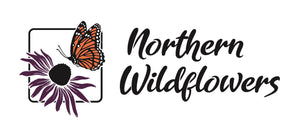The Colours of Attraction: How Flowers and Pollinators Evolve Together
Flower colour and pollinators have evolved in a fascinating relationship, where each influences the other in what’s called "coevolution." In North America, pollinators—including bees, birds, butterflies, and bats—have played a key role in shaping flower colouration, and vice versa. The colours of flowers are a form of adaptation, evolving to attract specific pollinators best suited to them. Let's explore how this works.

1. Colour Preferences of Pollinators
Bees: Bees are one of the most important kinds of pollinators in North America, and they tend to prefer blue and purple flowers. They can also see in the ultraviolet (UV) spectrum, so many flowers that rely on bee pollination have UV-reflective patterns, known as “nectar guides,” that lead bees directly to their nectar. Some nectar guides are visible to us, and others are not. Examples include plants like lupines and irises, which have evolved colours to suit bee vision.

Birds (especially hummingbirds): Birds generally have good colour vision and are especially attracted to red, orange, and sometimes pink. Red tubular flowers, in particular, have evolved in many species to cater to the hummingbirds found across North America, which have a strong preference for red hues. Flowers like columbines, cardinal flower, and trumpet vines exhibit these colours, which help signal their nectar availability to birds.

Butterflies: Butterflies are drawn to bright, warm colours like yellow, orange, and red. They rely heavily on sight for locating flowers and have a good sense of colour, though they also use smell. Flowers like milkweed and coneflowers have evolved to attract butterflies, showcasing these colours and often providing a flat landing surface.

Bats and Nocturnal Pollinators: Bats, which are fairly common as pollinators in the southwestern United States, have poor colour vision but are sensitive to contrast in low light. Flowers that attract bats or moths are typically white or pale, making them visible at dusk or night.
2. The Role of Coevolution
Coevolution is a reciprocal evolutionary change that occurs between two or more species. In the case of flowers and pollinators:
Flower colour evolves in response to the visual preferences of pollinators that are the most effective at transferring pollen for that particular flower species.
Pollinators, in turn, may evolve traits (such as specific beak or tongue shapes, in the case of hummingbirds and bees) that allow them better access to flowers with colours they’re drawn to.
This process creates a feedback loop, where flowers with colours that attract certain pollinators are more successfully pollinated, passing on those colour traits to future generations. Conversely, pollinators that can efficiently locate and feed from flowers in colours they can see well are more successful in reproduction.
3. Ecological Impacts and Adaptations
The colour-pollinator relationship has also been shaped by North America’s diverse ecosystems, from deserts and plains to forests and coastal areas. A couple of examples include:
- Desert plants, like those pollinated by bats, tend to be paler and bloom at night.
- Woodland plants, which are commonly pollinated by bees and butterflies, show more purples and blues, catering to the preferences of daytime pollinators.
- Many cultivated garden plants that did not evolve alongside native pollinators, or that have been modified significantly through artificial selection, no longer possess the traits that made them effective at attracting or sustaining pollinators.
4. Challenges and Future Evolution
Modern challenges, including habitat loss, invasive species, and climate change, have disrupted traditional pollinator-plant relationships. Of course host plant relationships (between butterflies, moths, sawflies, etc and their larval hosts) are more sensitive to these challenges. Although some native bees have specialized diets consisting of nectar and pollen from specific groups of plants, most native bees are generalists and can adapt their diets to the food sources available. So as rare plant species decline or are extirpated from a region, the insects that rely on them disappear as well. We've seen this in Ontario with the Karner Blue, the Mottled Duskywing, and many other butterfly and moth species.
In turn, as certain pollinators decline, plants that evolved specifically to rely on those pollinators may struggle to reproduce. This could affect flower colour evolution over time as it becomes more general or adapted to other, more available pollinators. Orchids are a prime example of this, and they have evolved very specialized characteristics over a very short time span (evolutionarily speaking). Some of our native orchids have extravagant nectar guides, and have evolved to trick bees using a combination of colour and scent.
The Calypso orchid (Calypso bulbosa) for example, also known as the fairy slipper, does not produce nectar yet it attracts bumblebees and other bees by looking and smelling as if it does. The Calypso orchid has evolved a colourful pink, showy flower that resembles flowers with rewards, tricking bees into landing and exploring the flower in search of nectar. When bees try to access the non-existent nectar, they inadvertently come into contact with the orchid’s pollen, transferring it when they move to the next flower.
The Calypso orchid (Calypso bulbosa) for example, also known as the fairy slipper, does not produce nectar yet it attracts bumblebees and other bees by looking and smelling as if it does. The Calypso orchid has evolved a colourful pink, showy flower that resembles flowers with rewards, tricking bees into landing and exploring the flower in search of nectar. When bees try to access the non-existent nectar, they inadvertently come into contact with the orchid’s pollen, transferring it when they move to the next flower.

In summary, the relationship between flower colour and pollinators in North America exemplifies the intricate coevolution between species. Flower colours are a window into understanding what kind of pollinators had the largest impact on a plant's reproductive success, and these hues are a testament to the deep evolutionary bonds connecting plants and pollinators across diverse North American landscapes.
